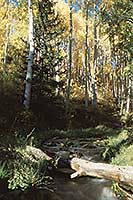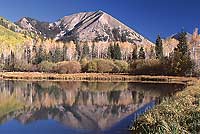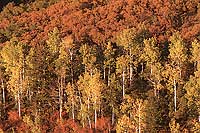As summer draws to a close, there is no better time to venture up into the La Sal Mountains and walk amongst the quakies. Verdant round leaves twist and turn in the slightest breeze because of their long stems and paddle-like leaves. Because of this trembling action, these trees are known as quaking aspens.
Mythology puts these trees along the road to Calvary where Christ was crucified. Because the trees refused to bow down as he passed by, they were doomed to shake and tremble for all eternity. Native peoples believed something similar, that because the trees didn’t honor the Great Spirit as it passed by them, they were condemned to live a life of submission and quake before the slightest breeze.
Aspens are the most widely distributed tree in North America, ranging across the northern portion of the United States and Canada. Narrowing that range to the western U.S., aspen groves are scattered across the landscape, confined to higher elevations and pockets in the vast sagebrush steppe landscape of the Intermountain West.
Though the trees can reproduce by seeds, they often reproduce asexually through suckers, where multiple stems arise from the same root system. Often cited as the largest known living organism on the planet, there is a grove of aspens in Utah’s Fishlake National Forest that covers over 100 acres and has thousands of stems.
Locally, aspen groves cloak the western slope of the La Sal Mountains. Remnant pockets of these trees do exist in lower canyon elevations, probably leftovers from the Pleistocene when a cooler climate prevailed and these trees could grow at lower elevations.
Up in the mountains, fall is a great time to wander through the aspen groves. Their clown-white bark is a stark contrast to the coniferous trees growing beside them, and one can swipe a finger across this bark and come away with a powdery coating, perfect for face painting. These trunks also have attracted lovers and Basque sheepherders, travelers and explorers who carved their names or initials into these trees over the years. Of course, this practice is frowned upon nowadays, but these arborglyphs provide a historical record of early adventurers.
You might not be alone while walking through a copse of aspens. Wildlife including mule deer, elk, coyotes, mountain lions, black bear, small mammals and birds may also be wandering in these groves. The herbivores feed on the grasses and shrubs that grow in the understory, while the predators follow their prey.
 Songbirds and raptors should be moving through these groves in September on their southbound migratory journey. Look for warblers, vireos, hummingbirds and hawks and eagles as they catch thermals and updrafts off of Wilson Mesa. Broad-winged and Swainson’s hawks are two of the rare species that pass through the area, the Swainson’s on a migratory sojourn that will take them to the pampas of Argentina where they will spend the winter hunting grasshoppers, beetles and other large insects.
Songbirds and raptors should be moving through these groves in September on their southbound migratory journey. Look for warblers, vireos, hummingbirds and hawks and eagles as they catch thermals and updrafts off of Wilson Mesa. Broad-winged and Swainson’s hawks are two of the rare species that pass through the area, the Swainson’s on a migratory sojourn that will take them to the pampas of Argentina where they will spend the winter hunting grasshoppers, beetles and other large insects.
As September rolls into October, the aspens should turn a brilliant yellow or golden color as the leaves lose their green chlorophyll. An occasional splash of orange or red may turn up in the leaves adding a unique punctuation in the leaves before these quakies drop all their leaves before the onset of winter.



 Songbirds and raptors should be moving through these groves in September on their southbound migratory journey. Look for warblers, vireos, hummingbirds and hawks and eagles as they catch thermals and updrafts off of Wilson Mesa. Broad-winged and Swainson’s hawks are two of the rare species that pass through the area, the Swainson’s on a migratory sojourn that will take them to the pampas of Argentina where they will spend the winter hunting grasshoppers, beetles and other large insects.
Songbirds and raptors should be moving through these groves in September on their southbound migratory journey. Look for warblers, vireos, hummingbirds and hawks and eagles as they catch thermals and updrafts off of Wilson Mesa. Broad-winged and Swainson’s hawks are two of the rare species that pass through the area, the Swainson’s on a migratory sojourn that will take them to the pampas of Argentina where they will spend the winter hunting grasshoppers, beetles and other large insects.